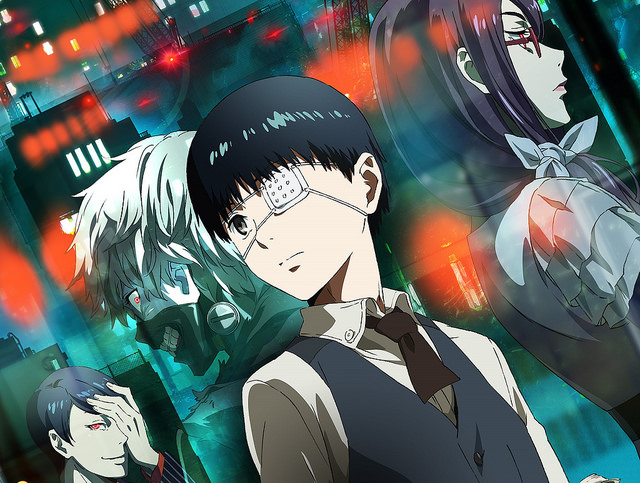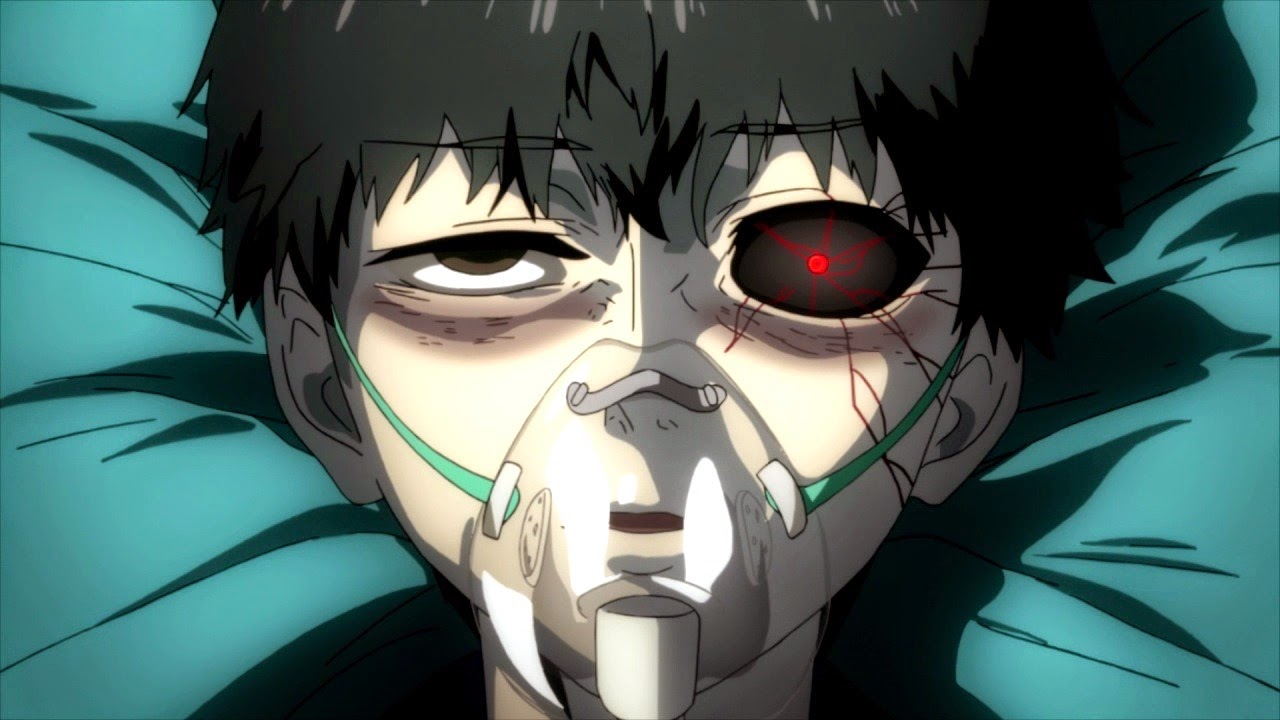
Is Tokyo Ghoul Good?
Tokyo Ghoul is one of the most popular anime to come out in recent years but is it good? Tokyo Ghoul is a good anime and worth the watch. The manga is very popular and I’m very aware that it’s better than the anime. This review of Tokyo Ghoul will be based on the anime alone.
Tokyo Ghoul is a dark fantasy, horror, thriller that was written and illustrated by Sui Ishida. It was adapted by studio Pierrot and aired on July 4, 2014.
The story follows Ken Kaneki, a college student who barely survives a deadly encounter with Rize Kamishiro, his date who reveals herself as a ghoul. He is taken to the hospital after suffering near death injuries. After recovering, Kaneki discovers that he underwent a surgery that transformed him into a half-ghoul. This was because some of Rize’s organs were transferred into his body.
In order to survive, he must consume human flesh. The ghouls who manage the coffee shop “Anteiku” take him in and teach him to deal with his new life as a half-ghoul. Some of his daily struggles include fitting into the ghoul society, as well as keeping his identity hidden from humans, especially from his best friend Hideyoshi Nagachika.
There are many themes and concepts explored in the anime. Kaneki struggles after turning into a ghoul, the horror elements, and the conflict between the ghouls and humans make Tokyo Ghoul a good anime to watch.
1. Ken Kaneki Struggling To Be A Ghoul
One of the elements that make Tokyo Ghoul intriguing is Kaneki’s struggles with his humanity. He desperately tries to keep his humanity and strongly tries to resist his desire to consume human flesh. This temptation is so strong that he almost kills his best friend Hideyoshi Nagachika. As a half-ghoul, he stands in the center of the conflict between the ghouls and humans.
2. Tokyo Ghoul Has Good Horror Elements
Another great element of Tokyo Ghoul are the gory and graphic scenes. The artwork of the series makes easier visually to capture the gruesome moments in the ghoul world.
There are many great horror elements in this show. For example, there is a scene in episode 5 where the ghoul Tsukiyama Huu (voiced by Mitsuru Miyamoto) kidnaps Nishio’s (another ghoul) human girlfriend Kimi as a hostage and hides her in a church. When Nishio comes to save her, Tsukiyama takes pleasure in torturing him. The atmosphere is creepy and it is a bloody, scary and intense scene. Overall, Tokyo Ghoul does a good job of setting the tone with it’s horror elements.
3. Conflict between Ghouls and Humans
In Tokyo Ghoul, there are entities known as ‘Ghouls’ who live among humans, but feed off human corpses. Ghouls are considered savage and harmful creatures that need to be eradicated. Ghouls find themselves constantly struggling for survival. There is a scene where Kaneki tells Touka (ghoul from Anteiku) ever since he became a half-ghoul, his life’s been hell. Touka responds by telling him the things that’s been robbed from her simply because she IS a ghoul (no sense of taste, living in fear of CCG, conflict with other ghouls). She tells Kaneki to get over himself and accept his new reality. This is a common theme in Tokyo Ghoul. There is a constant struggle for ghouls that try to live a “clean” life in the human world.
The humans are represented in this story through the CCG, a Ghoul Investigation agency dedicated to battle against ghouls. The CCG’s purpose is to secure the safety of the public. However, they do come head and head against Kaneki and the other ghouls.
The CCGs are able to fight the ghouls by using a special predatory organ called a kagune, which is made from the ghouls they have defeated in battle. By using the ghoul’s own weapon against them in combat, they are able to close the gap in strength. The consequences of these battles includes grief on both sides as they lose the people they love.
Tokyo Ghoul does a good job of not painting either side as evil. There are plenty of moments where you emphasize with both sides. There is even a moment in the anime where you ask how is it possible, for a pair of ghoul inspectors to seem so decent and compassionate (they worry for each other and mourn each other), and yet to be so thoroughly removed from any feelings towards the ghouls they kill? So much so that they would kill a ghoul mother in front of her ghoul child, and then kill the child after if given the chance? This is because they simply don’t view the ghouls as anything more than dangerous creatures that are a threat to human society.
Many of the humans take sadistic pleasure in killing ghouls. However, you see other ghouls too, such as Jason, Rize and Tsukiyama, engage in similar sadistic fashion. The ghouls are a species that not only needs to eat humans to survive, but has many members who also take sadistic pleasure in doing so. Some ghouls, such as Kaneki and Nishiki, have human values and yet ghouls are labeled by monsters to the public. The show does a good job of exploring important themes such as morality and prejudice.
The situation between the ghouls and the humans escalates over the course of the show and it results in an epic showdown. The last episode is well directed and very cinematic.
Tokyo Ghoul has it’s share of issues though, such as undeveloped characters, poor execution and it is very rushed. It would’ve been better if it was 2 cours. However, it is a series worth watching and has really good moments.
Is Tokyo Ghoul Root A Good?
Tokyo Ghoul Root A is a sequel to Tokyo Ghoul. It was also adapted by studio Pierrot but it deviates from the manga. It follows a more original story.
Tokyo Ghoul Root A suffers from being rushed and it lacks cohesion. The best part about Tokyo Ghoul Root A is Kaneki’s character development and the epic battle scene near the end of the series.
Kaneki’s Character Development
In the beginning of the Tokyo Ghoul, Kaneki lived by the sentiment that it’s better to be hurt than to hurt others. However, Kaneki changes drastically by the end of Tokyo Ghoul. In the beginning, he was timid, soft, and passive. In Tokyo Ghoul Root A, he’s more serious, assertive, stoic, and emotionless. He is more confident and his appearance also changes. This is where Kaneki becomes very interesting.
Seeing Kaneki go from being the wimpy protagonist he was to being a complete badass is a breath of fresh air and is definitely one of the highlights of Root A. Despite Kaneki’s change, he does not get much screen time for much of the beginning of Root A and his motivations are initially unclear.
Tokyo Ghoul Root A is Rushed
This leads to another major problem in regards to Tokyo Ghoul Root A, which is, it is too rushed. They tried to fit too many arcs in just 1 cour. Too many characters are introduced in a short time with no exposition or time to develop them. Tokyo Root A attempts to condense about 80 chapters and it does not do a good job.
Major story arcs are melded together so that the overall narrative is not very focused. There is no coherent progression from one event to the next. Questions that arise from the very first episode are never truly answered and the viewer is stuck in a state of confusion for most of the series. Things start to get better near the last three episodes. The pacing issues are more severe than in Tokyo Ghoul.
Ghoul vs CCG Battle
There is another epic showdown between ghouls and the CCG at the end of Tokyo Ghoul Root A. It is even better than the one in Tokyo Ghoul. The buildup to this battle was nicely done. The fight is visually excellent and well choreographed. This is particular refreshing because the animation in the first half of the series was poor. The beginning sequence of the fight is cinematic and it’s under the Glassy Sky instrumental.
The last three episodes of Tokyo Ghoul Root A are action-packed and has some of the series best moments. The last episode in particular is pretty controversial.
Overall, Tokyo Ghoul Root A is decent and has it’s bright moments.
Is Tokyo Ghoul:re Good?
Tokyo Ghoul:re is the third season of Tokyo Ghoul and is produced by studio Pierrot. However, director Shuhei Morita, who worked on Tokyo Ghoul and Tokyo Ghoul Root A, is absent from this project. Toshinori Watanabe was in charge of directing Tokyo Ghoul:re. The art style in Tokyo Ghoul:re is different from Tokyo Ghoul and Tokyo Ghoul Root A. As a result, many of the characters have minor changes to their character design and will look slightly different.
Tokyo Ghoul:re is essentially a reset. Our main protagonist, Ken Kaneki, undergoes another character transformation. After suffering a head injury from the last season’s battle, he becomes amnesiac. His entire identity change and he goes by the name of Haise Sasaki.
Tokyo Ghoul:re is not good and not worth the watch. If you haven’t read the manga, then many events in Tokyo Ghoul:re will seem confusing. Tokyo Ghoul:re ignores the Tokyo Ghoul Root A anime and stays true to the manga. Even if you read the manga, it is still a poor adaptation. The pacing is very fast and they try to rush through as many chapters as they can, resulting in a lackluster product. So many new characters are introduced and the fights will not have the same impact if you have not read the manga. The new cast is bland and generic. The best characters that were present in Tokyo Ghoul and Tokyo Root A get little screen time.
Whereas the OST in Tokyo Ghoul and Tokyo Root A was pretty memorable, the OST in Tokyo Ghoul:re is bad. The opening song, particularly, does not really fit and the ending song is meh.
Overall, Tokyo Ghoul:re is uninspired compared to Tokyo Ghoul, Tokyo Ghoul Root A. It is not worth watching. It’s better to just read the manga at this point.
Studio Pierrot did a poor job of adapting the manga in general and the Tokyo Ghoul franchise has suffered as a result
For more analysis, check out:
Anime Where MC is OP But Hides It
Is Boogiepop wa Warawanai (2019) Good?
Is The Promised Neverland Good?
Why One Punch Man Season 2’s Animation is Bad | Review
Levi vs Beast Titan | Attack On Titan Best Fight
Tanjiro vs Rui | Demon Slayer Best Fight


